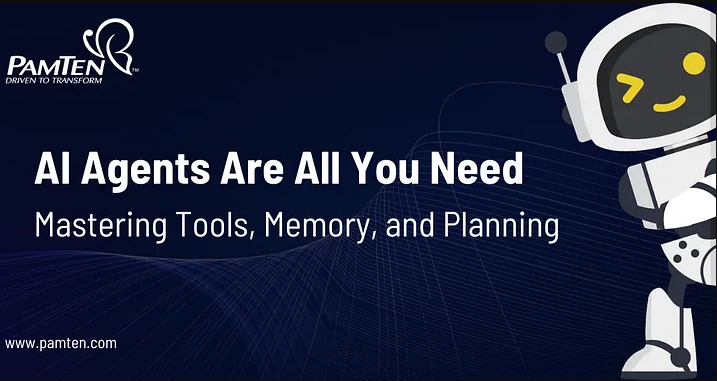
Artificial Intelligence (AI) is rapidly evolving, and while Large Language Models (LLMs) have made significant strides, they are transitioning towards more advanced AI agents and agentic workflows. LLMs, known for their capability to process vast amounts of language data, are indeed powerful, but they still face challenges in fully automating tasks independently. This article explores how AI agents leverage tools, memory, and planning to address these challenges and maximize efficiency.

From RAG to Agents
The journey from Retrieval-Augmented Generation (RAG) models to sophisticated AI agents represents a significant leap in AI capabilities. RAG models, which combine retrieval mechanisms with generation capabilities, laid the groundwork for more advanced systems. However, to achieve higher levels of autonomy and reliability, AI agents have emerged. These agents integrate LLMs with other tools to overcome limitations and enhance their performance in practical applications.
Agent System Overview
AI agents are systems designed to perceive their environment, process information, make decisions, and execute actions autonomously or semi-autonomously. They build on the foundation of LLMs but extend their capabilities by incorporating additional components:
- Tools: Enhance the agent’s ability to interact with and manipulate the environment.
- Memory: Allows the agent to store and utilize past experiences for better decision-making.
- Planning: Enables the agent to strategize and adapt its actions based on future goals and potential obstacles.
Tool Usage for AI Agents
The integration of tools with LLMs significantly amplifies the functionality of AI agents. Here’s how tools contribute to their efficiency:
- Data Collection and Analysis: Tools like web scrapers and data analyzers provide agents with real-time information, enabling them to respond to dynamic conditions.
- Execution and Interaction: Robotics and automation tools allow AI agents to perform physical tasks or interact with users through chatbots and voice assistants.
- Enhanced Processing: Specialized algorithms and software frameworks (e.g., TensorFlow, Apache Spark) support complex data processing and machine learning tasks, improving the agent’s overall effectiveness.
By utilizing these tools, AI agents can execute tasks with greater precision and adaptability, addressing some of the inherent limitations of LLMs.
Solving Memory Issues in Agentic Workflows
Memory plays a crucial role in AI agents, enabling them to learn from past experiences and make informed decisions. Two types of memory are essential:
- Short-Term Memory: Helps agents retain information temporarily for immediate tasks. For example, a virtual assistant uses short-term memory to remember the context of a current conversation.
- Long-Term Memory: Stores accumulated knowledge and experiences over time. An autonomous vehicle, for instance, uses long-term memory to improve navigation based on various driving conditions encountered.
Addressing memory issues involves implementing robust storage and retrieval mechanisms, ensuring that agents can effectively leverage past data without losing track or becoming inconsistent.
Planning: Biggest Problem of Current AI Agents
Effective planning is a significant challenge for current AI agents. It involves:
- Goal Setting: Defining clear objectives that guide the agent’s actions.
- Pathfinding and Optimization: Determining the most efficient actions or routes to achieve goals.
- Contingency Management: Preparing for potential obstacles and developing alternative strategies.
Current AI agents often struggle with dynamic and complex environments, where continuous adaptation and strategic decision-making are required. Enhancing planning capabilities involves developing more sophisticated algorithms and frameworks that can handle uncertainty and adapt to changing conditions.
Types of Agents
AI agents come in various types, each designed for specific functions:
- Simple Reflex Agents: React to specific stimuli without considering past experiences or future consequences.
- Model-Based Reflex Agents: Use internal models to make decisions based on current and past states.
- Goal-Based Agents: Plan and take actions to achieve specific goals, considering future outcomes.
- Utility-Based Agents: Assess the desirability of different outcomes to make decisions that maximize overall satisfaction.
- Learning Agents: Continuously improve their performance by learning from experiences and adapting their behavior.
Each type of agent has its strengths and weaknesses, and selecting the appropriate type depends on the specific application and requirements.
Conclusion
AI agents represent the next frontier in artificial intelligence, extending the capabilities of LLMs by integrating tools, memory, and planning. While challenges remain, particularly in the areas of memory management and strategic planning, the potential for AI agents to revolutionize various industries is immense. By understanding and leveraging these components, we can unlock new possibilities and drive innovation forward. To explore more about AI agents and their applications, visit PamTen.






Сколько стоит диплом высшего и среднего образования и как это происходит?
Официальное получение диплома техникума с упрощенным обучением в Москве
danceway74.ru/users/36
Как купить аттестат 11 класса с официальным упрощенным обучением в Москве